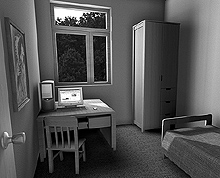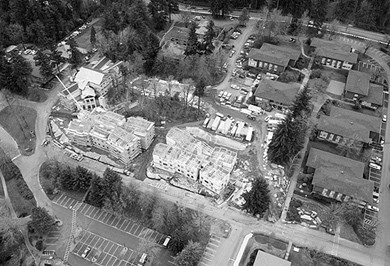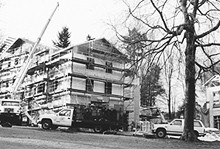New residence halls take shape
Open gallery

In September, the College will open the doors to three new residential “houses,” designed to meet the needs of juniors and seniors. Construction crews have been working through wind, rain, and even a dusting of snow to keep the project, which broke ground in spring 2001, on schedule.
Framing and sheathing are now complete on all three buildings. Workers are installing windows and roofs, and dehumidifiers are pumping moisture out of the buildings. Once interiors are dry, crews will install insulation and indoor plasterboard. Final site work and landscaping will begin in March, and the buildings will be substantially complete in July.
“I think the new residence halls are the most important undertaking on the campus right now,” says John Kemp, trustee and chair of the board’s Residence Life Task Force. “It makes Lewis & Clark a four-year residential experience. That means greater interaction between upperclass and first- and second-year students. “
The new halls (one three-story and two four-story buildings totaling approximately 80,000 square feet) will accommodate 167 students in two- and four-bedroom suites that include a shared living area, kitchen, and bathroom. In addition, the project features several gathering spaces for all students on campus, including a convenience store/coffee shop, recreation center, and copy center.
The cost of living in the new halls per semester is $1,785 (the standard room rate) plus a $500 premium, for a total of $2,285. That amounts to $100 more than the cost of one student opting to live alone in a standard residence hall after his or her roommate moves out. In addition, that cost includes all utilities, Internet service, phone service, voice mail, and the convenience of living on campus in an environmentally friendly setting.
“This project is one of the first Leadership in Energy and environmental Design (LEED)–certified green building projects in Oregon and the Northwest,” says David Lageson, facilities manager. “While green building has become a ubiquitous phrase in construction, the College has fully embraced it.”
LEED certification goes beyond any token claim to being “earth friendly.” LEED was developed by the U.S. Green Building Council to promote a more integrated approach between eco-friendly building goals and actual construction. The certification is based on a set of wide-ranging criteria for energy efficiency, air quality, water quality, type and origin of materials, and site use.
“This eco-friendly project, designed by SERA Architects and built by DPR Construction of Oregon, will benefit the College and the environment for many years,” Bettega says.
To arrange a tour of the new residence halls, contact Jon Eldridge, dean of students, at 503-768-7145 or jde@lclark.edu. Application materials for upperclass transfer students and continuing students who have lived on campus for two semesters are available in the Office of Residence Life and on the Web at www.lclark.edu/dept/reslife.

Above: An aerial view of the residence hall construction site. The south parking lot of Templeton Student Center appears in the foreground.

Above: One of the three new residential “houses” earmarked for juniors and seniors.
More L&C Magazine Stories
Lewis & Clark Magazine is located in McAfee on the Undergraduate Campus.
MSC: 19
email magazine@lclark.edu
voice 503-768-7970
fax 503-768-7969
The L&C Magazine staff welcomes letters and emails from readers about topics covered in the magazine. Correspondence must include your name and location and may be edited.
Lewis & Clark Magazine
Lewis & Clark
615 S. Palatine Hill Road MSC 19
Portland OR 97219

